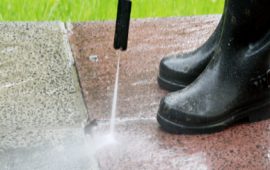TOP TIPS
- Protect tender plants by covering them with horticultural fleece
- Plant tulip bulbs
- Provide food and water for garden birds
- Visit Polhill to see the Christmas displays

Clear any fallen leaves from your lawn, pond and beds
Raise containers onto pot feet to prevent water logging
Plant tulip bulbs for a Spring display next year
Prune roses to prevent wind-rock
Plant out winter bedding
Cover brassicas with netting if pigeons are a problem
Stop winter moth damage to fruit trees by using grease bands around the trunks
Encourage birds in to your garden by putting out bird food
Use a seasonal bonfire – where this is allowed – to dispose of excess debris unfit for composting. Check for wildlife prior to this.
Continue to tidy beds and borders, then mulch with compost, well-rotted manure or bark and apply a slow release fertiliser such as bone meal.
Provide Autumn and Winter interest by leaving attractive stems or seed heads for wildlife. Cut back old, unsightly perennials to ground level though
Keep Autumn flowering plants looking their best by removing dead heads and ensuring they’re not being covered with fallen leaves.
Be sure to rake up leaves regularly to prevent them from smothering your grass. Either add them in small amounts to your compost heap or put them in large plastic bags to rot.
Protect plants in your greenhouse from cold winter nights with a heater
Water in the morning only, so that the foliage does not remain wet at night and try to avoid leaf splash.
Sow winter Lettuce in the greenhouse border soil.
Ventilate the greenhouse with care in order to keep up air movement and alleviate dampness without letting temperatures fall too low.
Insulate the greenhouse from frost – bubble wrap works well or purchase a bubble insulation pack.
Replenish birdfeeders, or hang one if you have not done so in previous seasons. All feeds, including peanuts, are safe, as the breeding season is now over
Clean out nesting boxes so that birds can shelter inside them during the winter
Leave some seed heads standing, rather than cutting them back, to provide food and shelter for wildlife
Leave mature ivy uncut if possible, as it is an excellent late source of nectar for insects
Make a leaf pile for hibernating mammals and ground-feeding birds overwintering in the UK
Generally clean up your pond taking care not to disturb hibernating wildlife.
Remove pumps and clean and store them in a dry place.
Put a net over the pond if not already to prevent leaves falling into it and regularly shake off leaves to prevent them from building up.
Drain stone fountains and water features so freezing conditions are less likely to cause damage.
Rake out fallen leaves from ponds that are not netted
Remove the last of the dead foliage from floating plants, such as water lilies, and from marginal plants that overhang the edge of the pond.
Watch out for hungry herons – they will deplete fish stocks quickly. Nylon strings strung across the edges of the pond (where they often wait for fish) can deter them from approaching the water. They need to be 15cm (6in) from the ground and 15cm in from the edge of the pond.


